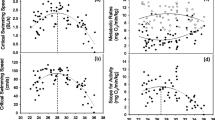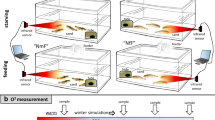Abstract
We investigated the behavioural responses of two gobiid fish species to temperature to determine if differences in behaviour and ventilation rate might explain any apparent vertical zonation. A survey of the shore at Manly, Moreton Bay revealed Favonigobius exquisitus to dominate the lower shore and Pseudogobius sp.4 the upper shore. These species were exposed to a range of temperatures (15–40°C) in aquaria for up to 6 h. At 20 °C F. exquisitus exhibited a mean gill ventilation rate of 26 ± 1.4 bpm (beats per minute) differing significantly from Pseudogobius, which ventilated at a fivefold greater rate of 143 ± 6 bpm. The ventilation rate in F. exquisitus underwent a fivefold increase from normal local water temperature (20 °C) to high temperature (35 °C) conditions, whereas that of Pseudogobius did not even double, suggesting that Pseudogobius sp. is a better thermal regulator than F. exquisitus.While both species emerged from the water at high temperatures (>30 °C) the behaviours they exhibited while immersed at high temperature were quite different. F. exquisitus undertook vertical displacement movements we interpret as an avoidance response, whereas Pseudogobius sp. appeared to use a coping strategy involving movements that might renew the water mass adjacent to its body. The thermal tolerances and behaviours of F. exquisitus and Pseudogobius sp. are in broad agreement with their vertical distribution on the shore.
Similar content being viewed by others
Explore related subjects
Discover the latest articles and news from researchers in related subjects, suggested using machine learning.References
Bridges, C. R., A. C. Taylor, S. J. Morris & M. K. Grieshaber, 1984. Ecophysiological adaptations in Blennius pholis (L. ) blood to intertidal rockpool environments. Journal of Experimental Marine Biology and Ecology 77: 151-167.
Chadwick, E. M. P., 1976. A comparison of growth and abundance for tidal pool shes in California and British Columbia. Journal of Fish Biology 8: 27-34.
Congleton, J. L., 1980. Observations on the responses of some southern California tidepool shes to nocturnal hypoxic stress. Comparative Biochemistry and Physiology 66A: 19-722.
Davenport, J. & A. D. Woolmington, 1981. Behavioural responses of some rocky shore sh exposed to adverse 72. environmental conditions. Marine Behaviour and Physiology. 8: 1-12.
Davis-Jana, L. D., 2001. Diel changes in habitat use by two tidepool shes. Copeia 2001: 835-841.
Davis-Jana, L. D., 2000. Changes in a tidepool sh assemblage on two scales of environmental variation: Seasonal and El Nino Southern Oscillation. Limnology and Oceanography. 45: 1368-1379.
Daxboeck, C. & T. A. Heming, 1982. Bimodal respiration in the intertidal sh, Xiphister atropurpureus (Kittlitz). Marine Behaviour and Physiology 9: 23-33.
Dejours, P., 1973. Problems of control of breathing in shes. In Bolis, L., K. Schmidt-Nielson & P. Maddrell (eds), Com-parative Physiology: Locomotion, Respiration, Transport and Blood. North Holland/American Elsevier, Amsterdam and New York: 117-133.
Dejours, P., A. Toulmond & J. P. Truchot, 1977. The effect of hyperoxia on the breathing of marine shes. Comparative Biochemistry and Physiology 58A: 409-411.
Gibson, R. N., 1969. The biology and behaviour of littoral fish. Oceanography and Marine Biology Annual Review 7: 367-410.
Gibson, R. N., 1982. Recent studies on the biology of intertidal fishes. Oceanography and Marine Biology Annual Review 20: 363-414.
Gibson, R. N., L. Robb, H. Wennhage & M. T. Burrows, 2002. Ontogenetic changes in depth distribution of juvenile. atf-ishes in relation to predation risk and temperature on a shallow-water nursery ground. Marine Ecology Progress Series 229: 233-244.
Grifiths, S. P., 2003. Rockpool ichthyofaunas of temperate Australia: species composition, residency and biogeographic patterns. Estuarine and Coastal Shelf Science 58: 173-186.
Grifiths, S. P., West, R. J. & Davis, A. R., 2003. Effects of intertidal elevation on the rockpool ichthyofaunas of tem-perate Australia. Environmental Biology of Fishes 68: 197-204.
Heath, A. G. & G. M. Hughes, 1973. Cardiovascular and respiratory changes during heat stress in rainbow trout (Salmo gairdneri). Journal of Experimental Biology 59: 323-338.
Hernandez, C. E., P. E. Neill, J. M. Pulgar, F. P. Ojeda & F. Bozinovic, 2002. Water temperature. uctuations and terri-toriality in the intertidal zone: two possible explanations for the elevational distribution of body size in Graus nigra. Journal of Fish Biology 61: 472-488.
Hill, J. V., W. Davison & I. D. Marsden, 1996. Aspects of the respiratory biology of two New Zealand intertidal shes, Acanthoclinus fuscus and Forsterygion sp. Environmental Biology of Fishes 45: 85-93.
Kwik, J. T. & I. R. Tibbetts, 1999. An assessment of carbon dioxide gassing as a sampling technique for studies of the nekton of soft-sediment intertidal pools. Hydrobiologia 405: 217-220.
Lazzari, M. A., S. Sherman, C. S. Brown, J. King, B. J. Joule, S. B. Chenoweth & R. W. Langton, 1999. Seasonal and annual variations in abundance and species composition of two nearshore sh communities in Maine. Estuaries 22: 636-647.
Marsden, I. D., 1999. Feeding, respiration, and aerial exposure in a scavenging cirolanid isopod from New Zealand. Journal of Crustacean Biology 19: 459-466.
Newell, R. C. & G. M. Branch, 1980. The in. uence of tem-perature on the maintenance of metabolic energy balance in marine invertebrates. Advances in Marine Biology 17: 29-396.
Nilsson, G. E., Hobbs, J. P., Munday, P. L. & Ostlund-Nilsson, S., 2004. Coward or braveheart: extreme habitat delity through hypoxia tolerance in a coral-dwelling goby. Journal of Experimental Biology 207: 33-39.
Prosser, C. L., 1973. Comparative Animal Physiology. W. B. Saunders Co., Philadelphia.
Pye nch, K. A., 1943. The intertidal ecology of Bardsey Island, North Wales, with special reference to the recolonization of rocky surfaces, and the rock-pool environment. Journal of Animal Ecology 12: 82-108.
Schmidt-Nielsen, K., 1997. Animal Physiology: Adaptation and Environment, 5th edn. Cambridge University Press, Cam-bridge, England;New York.
Smith, L. S., 1991. Introduction to Fish Physiology. Argent Laboratories Press, Seattle, Washington.
Southward, A. J., 1958. Note on the temperature tolerances of some intertidal animals in relation to environmental temper-atures and geographical distribution. Journal of the Marine Biological Association of the United Kingdom 37: 49-66.
Southward, A. J., S. J. Hawkins & M. T. Burrows, 1995. Sev-enty years 'observation of changes in distribution and abundance of zooplankton and intertidal organisms in the western English Channel in relation to rising sea temperature. Journal of Thermal Biology 20: 127-155.
Takada, Y., 1999. Influence of shade and number of boulder layers on mobile organisms on a warm temperate boulder shore. Marine Ecology Progress Series 189: 171-179.
Thomson, D. A. & C. E. Lehner, 1976. Resilience of a rocky intertidal sh community in a physically unstable environment. Journal of Experimental Marine Biology and Ecology 22: 1-29.
Wilkes, P. R. H., R. L. Walker, D. G. McDonald & C. M. Wood, 1981. Respiratory, ventilatory, acid-base and ion-oregulatory physiology of the white sucker Catostomus commersoni: the in. uence of hyperoxia. Journal of Experi-mental Biology 91: 239-254.
Williams, E. S. & H. Suryanarayanan, 1997. Resistance adapta-tion of three intertidal organisms on salinity and temperature. Journal of Animal Morphology and Physiology 44: 143-148.
Wright, W. G. and J. A. Raymond, 1978. Air-breathing in a California sculpin. Journal of Experimental Zoology 203: 171-176.
Author information
Authors and Affiliations
Rights and permissions
About this article
Cite this article
Ford, J., Tibbetts, I. & Carseldine, L. Ventilation rate and behavioural responses of two species of intertidal goby (Pisces: Gobiidae) at extremes of environmental temperature. Hydrobiologia 528, 63–73 (2004). https://doi.org/10.1007/s10750-004-2408-7
Issue Date:
DOI: https://doi.org/10.1007/s10750-004-2408-7




